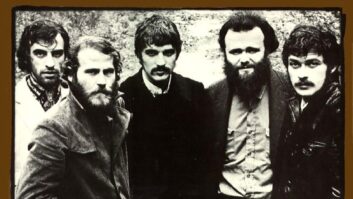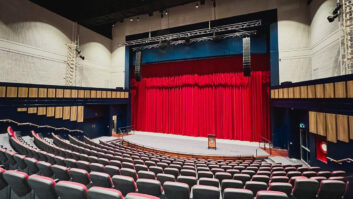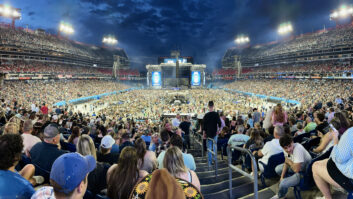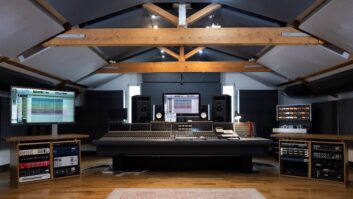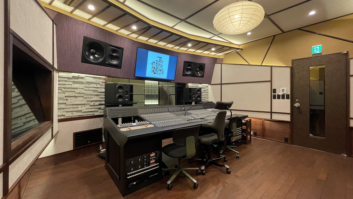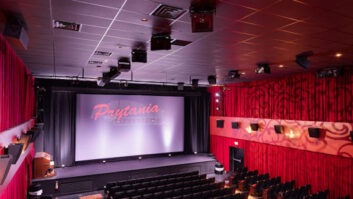Hard rock producer/engineer Joe Barresi held court during PMC and Vintage King’s The Producer and Composer Session at the recent ASCAP Expo in Los Angeles. HOLLYWOOD, CA—The audience for engineer, producer and mixer Joe Barresi’s presentation during the recent three-day ASCAP Expo in Hollywood was familiar with his work and well-prepared with questions regarding his studio techniques. But anybody expecting to pick up tips on sidechaining and parallel processing using plug-ins—apparently obsessions with the next generation—may have been disappointed: Barresi is decidedly old school.

Time and again, in every session during the Expo, someone would ask what plug-in the presenter used to sidechain one track with another. “I still mix in the analog style,” responded Barresi to the question—the very first to be asked—in his presentation during PMC and Vintage King’s The Producer and Composer Session on the second day.
“I have an SSL console. I believe when you’re mixing, you’re performing. I’m riding stuff—you hear the guitars come down in the verse? That’s me pulling them down to let the vocal breathe a little, then pushing them up where there’s no vocal,” Barresi elaborated.
“The thing about mixing analog-style through a console is that it makes it a lot harder to go back and perfect everything—which I like. Somebody knows ‘I can kick on my computer and hit a button and turn a hi-hat up a quarter-dB two weeks from now’ [but then] I’m massaging a song into nothing. I like imperfections.”
As he pointed out, “Jimi Hendrix didn’t use sidechain compression or parallel stuff. But I run my guitars through an extra set of mic pres and bring them up on faders, just like I would use parallel compression and distortion.” That way, he said, “I preserve the natural transients.”
Barresi has honed his skills in the studio working with some of the hardest-rocking guitar-based bands in the business: Queens of the Stone Age (and Kyuss, QOTSA frontman Josh Homme’s previous band), Tool, Bad Religion, Chevelle, Soundgarden, The Melvins, and numerous others. He was drawn to guitar from an early age, playing in bands in New York and Florida before heading west and switching to the other side of the studio glass. His Pasadena-area studio, JHOC (Joe’s House of Compression, formerly Kevin Gilbert’s Lawnmower and Garden Supplies facility), is stacked with guitars, amps and stompboxes.
Barresi is as much a fan as he is the consummate professional: “I still remember the first time I heard AC/ DC’s For Those About to Rock. I had to pull over. It blew my mind; it was that exciting. I still try to approach mixing as a fan of music.”
He also likes to keep it fun in the studio in order to inspire the musicians. “If you come into the studio and see an $8,000 microphone and everything looks like a hospital, you’re not going to have fun. But if you see some crazy mic through a little amp with a weird speaker on it, or a tiny Marshall Microstack inside a cooler with a 57 jacked into it, you’re going to get excited,” he said.
“Those are unique sounds that nobody gets. Separate yourself from everybody else. Everybody has the same plug-ins. I use plug-ins, but I also make my own—I plug s— in!”
Barresi frequently sees a project through from start to finish. “I usually mix most of the stuff that I produce and record,” he explained. “When I’m tracking, I know what it’s going to sound like when I’m done, so I can push the envelope and carve some [frequencies] out if I have to. I’m not cutting frequencies out of guitars. I put guitars down first and mold the bass into the guitar sound.”
He recently did a shoot-out between 19 bass DIs, he added. “The bass DI is the key to every bass sound.”
His approach to low end also includes sub-harmonic processing: “I use Aphex 204s on toms. I like the Furman Punch 10 on the kick drum, because it’s tight. I like the dbx Boom Box on bass.”
But his involvement in a project typically starts well before the first day in the studio. “I’m really into pre-production. Fleetwood Mac used to sit in the studio for four years; no one has that kind of money anymore. I can get a record out in four weeks, and pre-production is a huge part of it.” For example, he said, QOTSA’s Lullabies to Paralyze album was done in 17 days.
Getting a band comfortable in the studio is also key. “Get a performance,” he said, and don’t worry about the imperfections. “There’s a new Chevelle song on the radio right now. My friend, who’s a great engineer, said, ‘You should have gone in and edited those drums a little bit.’ I said, ‘maybe you’ve forgotten what a real drummer sounds like.’” The fans certainly had no problem with the release, La Gárgola, which reached #3 in the Billboard 200 in mid-April.
“The kind of music I work on, most of it is not very tight,” he continued. “People say I need to tighten up s—, sidechain my bass and kick drum. F— that!” Fans of a band don’t care about the sound of the kick drum, so don’t obsess over the details, he advised. “They just want the feeling. They hear a vocal that’s up front and beautiful and they connect with it. Never solo anything; just jam it all together and get excited about it.”
Vintage King Audio
vintageking.com


